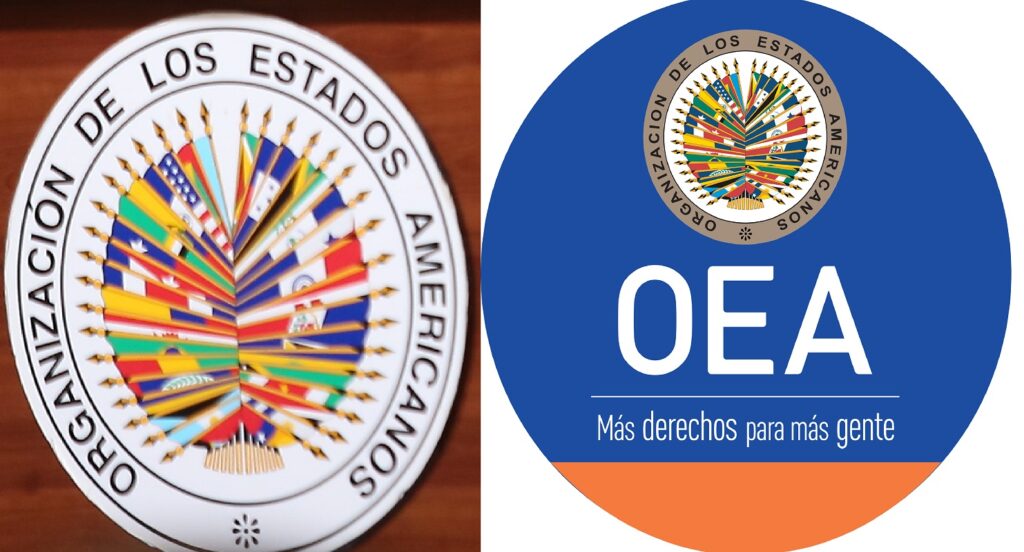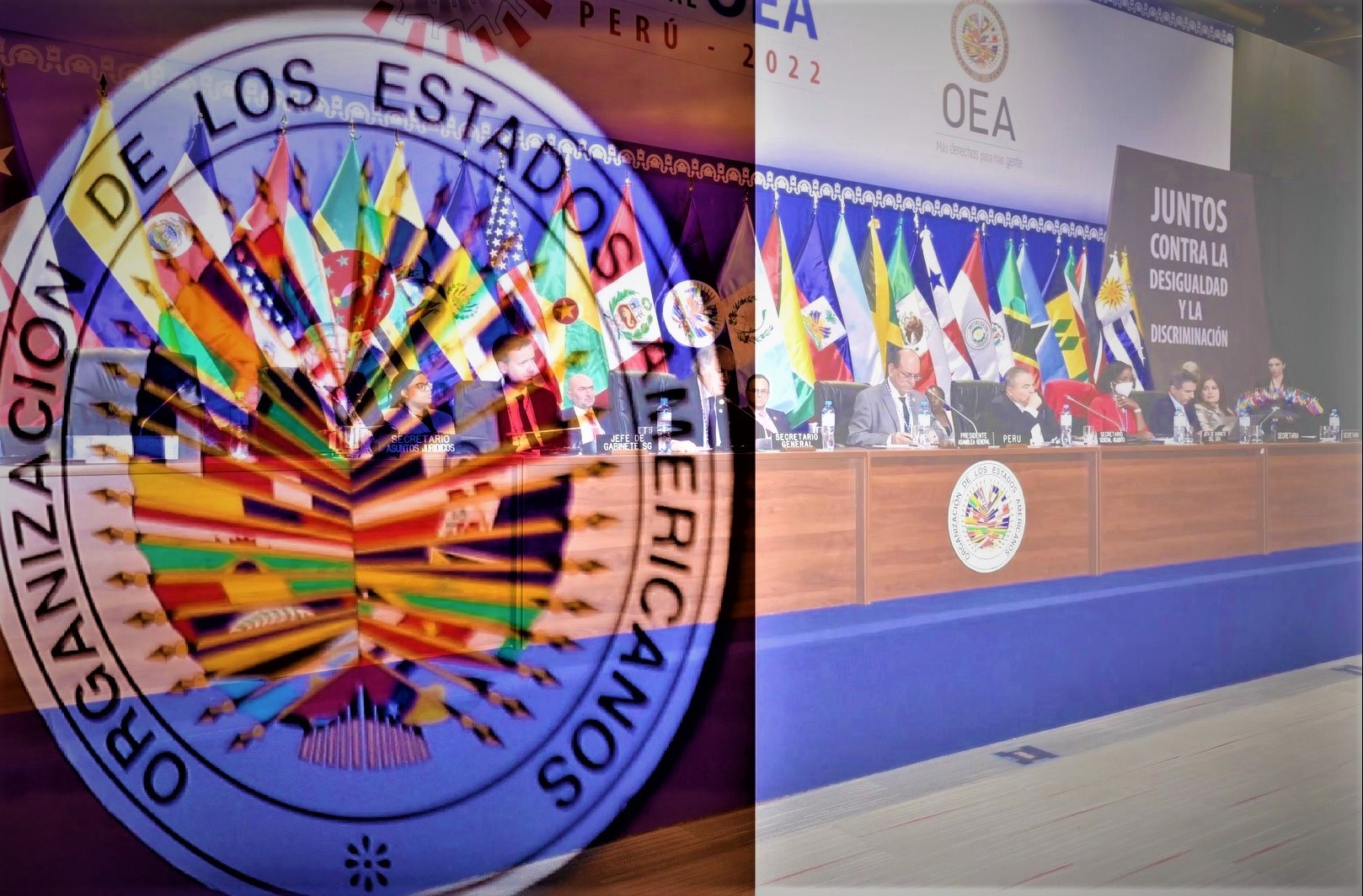Agencia Peruana de Noticias PRENSAPERU.PE https://prensaperu.pe Twitter: @prensaperupe Hoy lunes 21 de noviembre al promediar las 08:00 horas en Palacio de Gobierno el jefe de Estado peruano Pedro Castillo Terrones, recibe a la Misión de la Organización de los Estados Americanos – OEA, con quienes desarrollará una audiencia en el marco de los artículos 17 y 18 de la Carta Democrática Interamericana.
La delegación está integrada por los cancilleres de Argentina, Belize, Costa Rica, Ecuador, Guatemala, Paraguay (representante de la Secretaría General de la OEA y vocero del Grupo), y la Viceministra de Asuntos Multilaterales de Colombia.
¿POR QUÉ LA OEA ENVÍA U GRUPO DE ALTO NICVEL AL PERÚ?
El gobierno del Presidente Pedro Castillo solicitó, invocando los Artículos 17 y 18 de la Carta Democrática Interamericana, adoptada en Lima, Perú, el 11 de septiembre de 2001, el apoyo de los Estados Miembros por considerar que en Perú estaba amenazada la institucionalidad del país. La solicitud se realizó mediante una carta dirigida al Secretario General de la OEA, Luis Almagro, en la que el gobierno peruano expresaba su voluntad de establecer un proceso de diálogo con todos los actores en Perú para recuperar la normalidad democrática. Posteriormente, el Canciller de Perú, César Landa, ratificó la solicitud.
¿QUÉ VA A HACER EL GRUPO DE ALTO NIVEL EN PERÚ?
El grupo va a escuchar. El objetivo del Grupo es reunirse con la mayor cantidad de personas, colectivos, e instituciones, escuchar al mayor número de voces que tengan algo que aportar sobre la situación actual en Perú, para preparar un informe lo más completo posible al Consejo Permanente.
¿QUÉ DECISIONES PUEDE TOMAR EL GRUPO DE ALTO NIVEL SOBRE LA SITUACIÓN EN PERÚ?
Ninguna. La función del grupo es informarse sobre la situación en Perú escuchando a los peruanos y peruanas y, después de concluida su visita, preparar un informe que será presentado posteriormente al Consejo Permanente de la OEA.
¿QUÉ AUTORIDAD TIENE LA OEA PARA ENVIAR UN GRUPO DE ALTO NIVEL A PERÚ?
La Carta Democrática Interamericana , aprobada en Lima en 2001 por aclamación de todos los Estados Miembros, incluido por supuesto Perú, establece en su artículo 17 que el gobierno de cualquier Estado Miembro podrá solicitar en cualquier momento asistencia a la OEA para fortalecer y preservar su institucionalidad democrática. El Grupo de Alto Nivel va a Lima a petición del gobierno de Perú, como establece la Carta.
¿QUÉ MANDATO TIENE EL GRUPO DE ALTO NIVEL?
El mandato específico del grupo es realizar una visita a Perú con el fin de hacer un análisis de la situación en Perú y posteriormente informar a todos los Estados Miembros. Una vez recibido ese informe, serán los Estados Miembros, reunidos en el Consejo Permanente, los que decidirán cómo proseguir. La resolución que determina la creación del Grupo está disponible aquí.
¿QUÉ LEGITIMIDAD TIENE EL GRUPO DE ALTO NIVEL?
El mandato del Grupo de Alto Nivel tiene la máxima legitimidad, por cuanto se apoya en los principios de la Carta Democrática Interamericana, aceptada por todos los Estados Miembros, y porque la resolución que ordena su creación fue aprobada por unanimidad por el Consejo Permanente de la OEA, es decir, con el apoyo de todos los Estados Miembros. La intención del apoyo que prestan los Estados Miembros de la OEA está indicado desde el título mismo de la resolución: “Respaldo a la preservación de la institucionalidad democrática y la democracia representativa en el Perú”.
¿QUIÉN COMPONE EL GRUPO DE ALTO NIVEL Y CÓMO SE DECIDIÓ SU INTEGRACIÓN?
La integración del Grupo de Alto Nivel fue decidida por el Presidente del Consejo Permanente, el Embajador de Suriname ante la OEA Marten Schalkwijk, después de realizar consultas con el resto de los Estados Miembros. El grupo está compuesto por:
• Santiago Cafiero, Ministro de Relaciones Exteriores, Comercio Internacional y Culto de Argentina
• Eamon Courtenay, Ministro de Relaciones Exteriores, Comercio Internacional e Inmigración de Belize
• Arnoldo André, Ministro de Relaciones Exteriores de Costa Rica
• Juan Carlos Holguín, Ministro de Relaciones Exteriores y Movilidad Humana del Ecuador
• Mario Adolfo Búcaro, Ministro de Relaciones Exteriores de Guatemala
• Julio César Arriola, Ministro de Relaciones Exteriores del Paraguay
• Laura Gil, Viceministra de Asuntos Multilaterales de Colombia
• Eladio Loizaga, ex Ministro de Relaciones Exteriores del Paraguay, representante de la Secretaría General de la OEA y vocero del Grupo
¿TIENE EL GRUPO DE ALTO NIVEL UNA IDEA PRECONCEBIDA SOBRE LA SITUACIÓN EN PERÚ?
No. El Grupo llega a Perú a escuchar y reflejará lo que escuche en su informe. El punto de partida del trabajo del Grupo será la institucionalidad del Estado peruano, reflejada en su Constitución y todas las leyes que la desarrollan. El Grupo no viaja para refrendar las tesis de una u otra parte, sino para elaborar un informe sobre la situación.
¿CUÁNDO LLEGA EL GRUPO DE ALTO NIVEL A PERÚ?
El Grupo llegará a Perú el domingo 20 de noviembre y concluirá sus labores el miércoles 23 de noviembre.
¿CON QUIÉN SE REUNIRÁ EL GRUPO DURANTE SU VISITA?
El objetivo declarado del Grupo es reunirse con la mayor cantidad posible de instituciones, personas y colectivos que desempeñan un papel relevante para el respaldo y la preservación de la institucionalidad de Perú. Así, el Grupo tiene previsto reunirse con representantes de los poderes ejecutivo, legislativo y judicial; del gobierno y de la oposición; con organizaciones y grupos religiosos, de empresarios, de la sociedad civil y de los sindicatos, entre otros.
¿CUÁNDO PRESENTARÁ SU INFORME EL GRUPO DE ALTO NIVEL?
No existe una fecha determinada ni un plazo que sea necesario cumplir. El Grupo se ha manifestado sin embargo consciente de la importancia de presentar el informe en el plazo más breve posible. Posteriormente, corresponderá a la Presidencia del Consejo Permanente la convocatoria de una reunión para la presentación del informe.
Fuente: Agencia Peruana de Noticias PRENSAPERU.PE https://prensaperu.pe Twitter: @prensaperupe

English translation
Head of State Pedro Castillo and the Mission of the Organization of American States (OAS) meet today at the Government Palace in Lima.
Peruvian News Agency PRENSAPERU.PE https://prensaperu.pe Twitter: @prensaperupe Today, Monday, November 21, at an average of 08:00 hours in the Government Palace, the Peruvian head of State Pedro Castillo Terrones, receives the Mission of the Organization of American States – OAS, with whom it will hold a hearing within the framework of Articles 17 and 18 of the Inter-American Democratic Charter.
The delegation is made up of the foreign ministers of Argentina, Belize, Costa Rica, Ecuador, Guatemala, Paraguay (representative of the OAS General Secretariat and spokesperson for the Group), and the Vice Minister of Multilateral Affairs of Colombia.
WHY IS THE OAS SENDING A HIGH-LEVEL GROUP TO PERU?
The government of President Pedro Castillo requested, invoking Articles 17 and 18 of the Inter-American Democratic Charter, adopted in Lima, Peru, on September 11, 2001, the support of the Member States for considering that in Peru the institutionality of the country was threatened . The request was made through a letter addressed to the Secretary General of the OAS, Luis Almagro, in which the Peruvian government expressed its willingness to establish a process of dialogue with all the actors in Peru to recover democratic normality. Subsequently, the Foreign Minister of Peru, César Landa, ratified the request.
WHAT IS THE HIGH-LEVEL GROUP GOING TO DO IN PERU?
The group will listen. The objective of the Group is to meet with the greatest number of people, groups, and institutions, to listen to the greatest number of voices that have something to contribute about the current situation in Peru, in order to prepare the most complete report possible for the Permanent Council.
WHAT DECISIONS CAN THE HIGH-LEVEL GROUP MAKE ON THE SITUATION IN PERU?
None. The group’s function is to find out about the situation in Peru by listening to Peruvians and, after the visit is over, to prepare a report that will be presented later to the OAS Permanent Council.
WHAT AUTHORITY DOES THE OAS HAVE TO SEND A HIGH-LEVEL GROUP TO PERU?
The Inter-American Democratic Charter, approved in Lima in 2001 by acclamation of all the Member States, including of course Peru, establishes in its Article 17 that the government of any Member State may request assistance from the OAS at any time to strengthen and preserve its institutionality. democratic. The High Level Group goes to Lima at the request of the Peruvian government, as established in the Charter.
WHAT MANDATE DOES THE HIGH-LEVEL GROUP HAVE?
The specific mandate of the group is to visit Peru in order to analyze the situation in Peru and subsequently report to all Member States. Once that report is received, it will be the Member States, meeting in the Permanent Council, that will decide how to proceed. The resolution determining the creation of the Group is available here.
WHAT LEGITIMACY DOES THE HIGH-LEVEL GROUP HAVE?
The mandate of the High Level Group has the utmost legitimacy, since it is based on the principles of the Inter-American Democratic Charter, accepted by all Member States, and because the resolution ordering its creation was unanimously approved by the Permanent Council of the OAS, that is, with the support of all Member States. The intention of the support provided by the OAS Member States is indicated from the very title of the resolution: “Support for the preservation of democratic institutions and representative democracy in Peru.”
WHO MAKES UP THE HIGH-LEVEL GROUP AND HOW WAS ITS INTEGRATION DECIDED?
The membership of the High Level Group was decided by the Chairman of the Permanent Council, the Ambassador of Suriname to the OAS Marten Schalkwijk, after holding consultations with the rest of the Member States. The group is composed of:
• Santiago Cafiero, Minister of Foreign Affairs, International Trade and Worship of Argentina
• Eamon Courtenay, Minister of Foreign Affairs, International Trade and Immigration of Belize
• Arnoldo André, Minister of Foreign Affairs of Costa Rica
• Juan Carlos Holguín, Minister of Foreign Affairs and Human Mobility of Ecuador
• Mario Adolfo Búcaro, Minister of Foreign Affairs of Guatemala
• Julio César Arriola, Minister of Foreign Affairs of Paraguay
• Laura Gil, Vice Minister of Multilateral Affairs of Colombia
• Eladio Loizaga, former Minister of Foreign Affairs of Paraguay, representative of the OAS General Secretariat and spokesperson for the Group
DOES THE HIGH-LEVEL GROUP HAVE A PRECONCEIVED IDEA ABOUT THE SITUATION IN PERU?
No. The Group comes to Peru to listen and will reflect what it hears in its report. The starting point of the Group’s work will be the institutionality of the Peruvian State, reflected in its Constitution and all the laws that develop it. The Group does not travel to endorse the theses of one party or another, but to prepare a report on the situation.
WHEN DOES THE HIGH-LEVEL GROUP ARRIVE IN PERU?
The Group will arrive in Peru on Sunday, November 20 and will conclude its work on Wednesday, November 23.
WHO WILL THE GROUP MEET DURING YOUR VISIT?
The declared objective of the Group is to meet with the largest possible number of institutions, individuals and groups that play a relevant role in supporting and preserving Peru’s institutions. Thus, the Group plans to meet with representatives of the executive, legislative and judicial powers; of the government and the opposition; with religious organizations and groups, businessmen, civil society and unions, among others.
WHEN WILL THE HIGH-LEVEL PANEL PRESENT ITS REPORT?
There is no specific date or deadline that must be met. The Group has, however, stated that it is aware of the importance of submitting the report as soon as possible. Subsequently, it will be up to the Chair of the Permanent Council to call a meeting to present the report.
Source: Peruvian News Agency PRENSAPERU.PE https://prensaperu.pe Twitter: @prensaperupe
